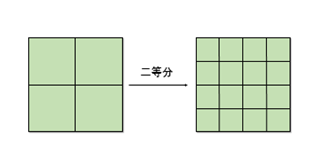Instructions
Resampling is the operation of changing the resolution of a raster dataset, which can be divided into upsampling and downsampling based on the change in resolution. Upsampling means that the cell edge length decreases and the number of cells increases, while downsampling means that the cell edge length increases and the number of cells decreases. When upsampling, when the specific value of the edge length is uncertain, the number of equal divisions can be specified to divide the edge length of the grid equally, such as 2 equal divisions, 4 equal divisions, 6 equal divisions, etc. This process is called equal resampling.

As shown in the above figure, the grid on the right is the result of resampling the edge length of the left grid evenly.
Usage scenario
For example, a 30 meter resolution latitude and longitude coordinate system grid needs to be resampled to 10 meters, but latitude and longitude data needs to convert the size of cells to degrees. In this case, we may encounter situations where we cannot divide by integer and can only be accurate to the last few decimal places. By using equal division resampling, the problem of inaccurate filling in manual calculation of meter rotation can be solved.
Parameter Specification
| Parameter Name | Default Value | Parameter Definition | Parameter Type |
|---|---|---|---|
| RasterRDD to be analyzed | RasterRDD that requires resampling | RasterRDD | |
| Number of equal divisions | 2 | The equal division value for the grid edge length, which must be greater than 1 | Int |
| Resampling Method | Nearest Neighbor Method | Resampling Method, including Nearest Neighbor Method, Bilinear Interpolation Method, Cubic Convolutional Interpolation Method, Cubic Spline Interpolation Method, Lanczos Method, Mean Value Method. For detailed introduction, please refer to the 'Resampling' operator | JavaResampleMethod |



